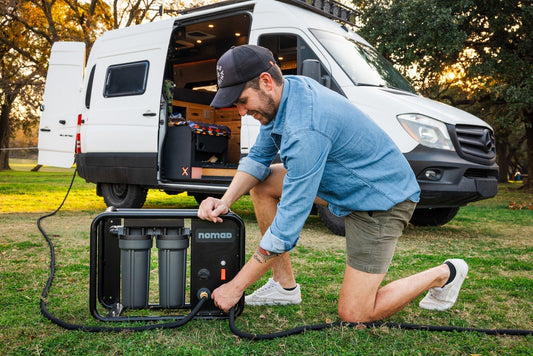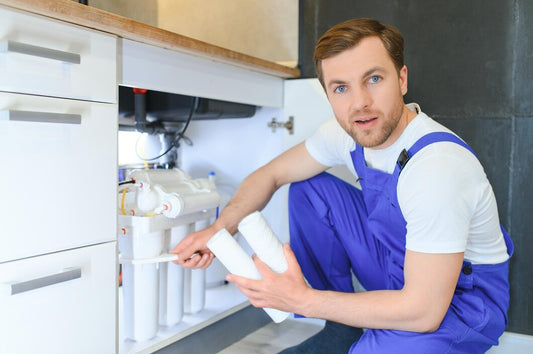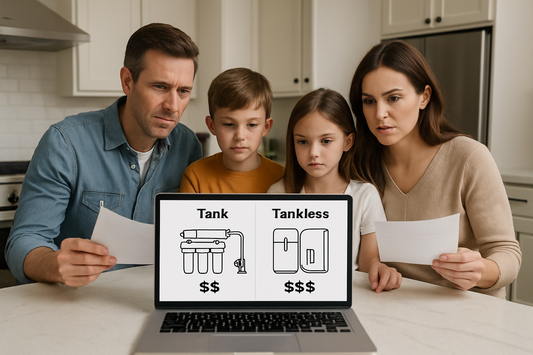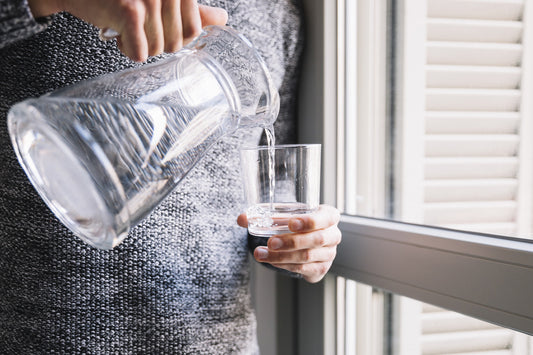Water Filter Cartridge Replacement: When & How to Change Your System
Picture this: You're filling your morning coffee mug, and suddenly you notice the water tastes... off. Maybe it's flowing slower than usual, or there's a strange smell that wasn't there last week. Sound familiar? You're not alone—and you've just experienced the classic signs that it's time for a cartridge water filter replacement.
Every homeowner who's invested in clean water deserves to know exactly when their system needs attention. Whether you're a busy parent juggling family schedules or a health-conscious professional who relies on pure water, understanding your filter's needs isn't just about maintenance—it's about protecting what matters most.
The Real Cost of Ignoring Filter Maintenance
Let's be honest: nobody wakes up excited about filter maintenance. But here's what happens when we put it off. Sarah, a working mom from Denver, ignored her system's warning signs for months. "I kept telling myself I'd deal with it next weekend," she recalls. "Then my kids started complaining about the water taste, and I realized I'd been serving them increasingly contaminated water for weeks."
The reality is that procrastination with water filter cartridge replacement doesn't just affect taste—it impacts your family's health, your system's lifespan, and ultimately, your wallet.

Image by freepik
When to Change Water Filter: The Signs You Can't Ignore
The Obvious Warning Signals
Your water system communicates with you constantly. The key is learning its language:
Flow Rate Changes: If your once-powerful stream has become a disappointing trickle, your cartridge is likely clogged with months of trapped contaminants.
Taste and Odor Shifts: That metallic taste or chlorine smell? Your filter has reached its capacity and can no longer remove impurities effectively.
Visual Clues: Cloudy water, visible particles, or discoloration are your system's way of waving a red flag.
The Hidden Timeline Factor
Most homeowners don't realize that filter effectiveness diminishes gradually. Even without obvious signs, cartridges typically need replacement every 6-12 months, depending on your water quality and usage patterns.
Think of it like this: would you drive your car 15,000 miles without an oil change? Your water filter works just as hard, processing hundreds of gallons monthly while trapping everything from sediment to chemical contaminants.
Understanding Your Water Filter Investment
Why Quality Matters More Than Price
Here's where many homeowners get tripped up: they assume all filters are created equal. The truth is, your filter choice directly impacts how often you'll need replacements and how well your system performs.
Whole House Systems: If you're dealing with comprehensive water quality issues throughout your home, a whole house filtration system provides complete protection. These systems require larger cartridges but offer superior coverage for families concerned about shower water, cooking water, and drinking water quality.
Under-Sink Solutions: For targeted kitchen use, under-sink systems offer convenience and effectiveness. These compact units excel at providing purified water exactly where you need it most—at your primary consumption point.
The Technology Behind Better Water
Modern filtration technology has evolved dramatically. Today's advanced cartridges use multi-stage filtration, combining activated carbon, sediment filters, and specialized media to address specific contaminants. When you invest in quality replacement cartridges, you're not just maintaining your system—you're upgrading your water quality.

Image by freepik
Step-by-Step Water Filter Cartridge Replacement
Preparation: Setting Yourself Up for Success
Before you begin, gather these essentials:
- New cartridge (model-specific)
- Adjustable wrench
- Towels or drop cloths
- Container for catching water
- Gloves (optional but recommended)
Pro tip: Take a photo of your current setup before starting. This visual reference can be invaluable if you need to troubleshoot later.
The Replacement Process
Step 1: Shut Off Your Water Supply Locate your system's shut-off valve. This crucial step prevents flooding and makes the entire process manageable.
Step 2: Depressurize the System Turn on your filtered water tap to release any remaining pressure. This prevents unexpected water sprays during cartridge removal.
Step 3: Remove the Old Cartridge Using your wrench, carefully unscrew the filter housing. Work slowly—rushing here often leads to spills and frustration. Keep the housing upright to prevent contaminated water from spilling.
Step 4: Install Your New Cartridge Remove all packaging from your new cartridge. Align it carefully with the housing threads, then hand-tighten before using your wrench for the final secure fit.
Step 5: System Flush and Testing Turn your water supply back on and run water through the system for several minutes. This flush removes any air pockets and ensures proper flow.
Troubleshooting Common Replacement Issues
When Things Don't Go as Planned
Persistent Leaks: If you notice dripping after installation, don't panic. First, ensure the cartridge is properly seated and tightened. If leaks continue, check the O-rings—they may need replacement or lubrication.
Reduced Water Pressure: New cartridges sometimes cause temporary pressure changes. Run water for 10-15 minutes to allow the system to stabilize.
Unusual Tastes Initially: Don't be alarmed if your first few glasses taste different. New cartridges often need time to "break in."

Image by freepik
Making Smart Replacement Decisions
Choosing the Right Replacement Strategy
Your replacement approach should match your household's unique needs:
High-Usage Households: If you're processing significant water volumes daily, consider premium cartridges with extended lifespans. The upfront cost often balances out with longer replacement intervals.
Quality-Focused Families: For households prioritizing maximum purity, specialized cartridges targeting specific contaminants (like chloramine or heavy metals) provide superior results.
Budget-Conscious Approaches: Standard replacement schedules with quality cartridges often provide the best value over time.
The Environmental Impact of Smart Choices
Sustainable Filtering Practices
Every cartridge replacement decision affects more than just your water quality. Modern consumers increasingly consider environmental impact:
Recycling Programs: Many manufacturers now offer cartridge recycling programs, turning used filters into new products rather than landfill waste.
Efficiency Improvements: Newer cartridge technologies process more water per unit, reducing overall waste while maintaining superior filtration.
Long-term Thinking: Investing in quality replacement cartridges often means fewer changes over time, reducing packaging waste and environmental impact.
Advanced Maintenance Strategies
Extending Your System's Life
Regular Monitoring: Keep a simple log of replacement dates and water quality observations. This data helps you identify patterns and optimize your replacement schedule.
Seasonal Considerations: Some areas experience seasonal water quality changes. Adjusting your replacement timing accordingly can improve both performance and cost efficiency.
Professional Assessment: Annual professional inspections can identify potential issues before they become expensive problems.

Image by pressfoto
When to Consider System Upgrades
Recognizing Upgrade Opportunities
Sometimes frequent cartridge replacements signal that your current system no longer meets your needs:
Increasing Replacement Frequency: If you're changing cartridges more often than manufacturer recommendations, your water quality may have changed or your system may be undersized.
Expanding Household Needs: Growing families or changed water usage patterns might require system upgrades rather than just more frequent replacements.
Technology Improvements: Newer filtration technologies can offer better performance, longer cartridge life, and improved convenience features.
Your Next Steps: Taking Action
Creating Your Maintenance Plan
The difference between homeowners who enjoy consistently clean water and those who struggle with system issues often comes down to planning:
- Mark Your Calendar: Set replacement reminders based on your specific system and usage patterns
- Stock Smart: Keep one spare cartridge on hand to avoid emergency situations
- Document Everything: Track replacement dates, water quality observations, and any issues
Making the Investment
Quality water filtration isn't just about the initial system purchase—it's about maintaining that investment through proper cartridge replacement. Whether you need whole house filtration solutions for comprehensive coverage or under-sink systems for targeted kitchen use, the key is consistency in maintenance.
Conclusion: Your Water, Your Health, Your Choice
Water filter cartridge replacement isn't just maintenance—it's an investment in your family's health and your home's value. By understanding when to change water filter cartridges and following proper replacement procedures, you're taking control of one of your most essential daily resources.
Remember, every glass of clean water starts with a properly maintained filter. Don't wait for obvious warning signs to take action. Your future self (and your family) will thank you for staying ahead of the curve.
Ready to take the next step? Your water system is counting on you to make the right choice.





